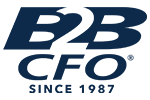
Six Strategic Questions You Should Be Asking Your CFO
Posted on June 12, 2023 by B2B CFO
As a business owner or CEO, understanding your company’s financial footing is crucial to making informed decisions that drive growth and success. But if you are not a finance expert yourself, it can be challenging to know where to start. For guidance, this list of six essential questions to ask your CFO will help you unlock the potential of your company’s finances so you can make better-informed decisions.
1. What are our company’s revenue streams, and how do they contribute to our overall financial picture?
To gain a comprehensive understanding of revenue streams, it is essential to consider all sources of income. This may include sales revenue, service revenue, interest income, and any other streams specific to your business. Your CFO can help you by analyzing the contribution of each of these income streams to understand which areas are performing well and which may need improvement. For example, if your company is looking to further improve recurring revenue, your CFO can create strategies from upselling to cross-selling to exploring new markets and channels to implementing a comprehensive list of action plans that can help you unlock new growth opportunities. By having a clear picture of the sources of income that drive your business, owners and management can make informed decisions that will ultimately lead to growth and profitability.
2. What are our biggest expenses and are there any areas where we could cut costs without sacrificing quality?
Keeping costs under control plays a major role in achieving profitability. However, it can be challenging to manage expenses while still maintaining the quality of your products or services, especially in an inflationary environment. Your business advisor and CFO can provide a profitability analysis to help you effectively manage cost control in your business by determining what products and services are profitable as well as what expenses are draining your profits. Through various benchmarking tools such as the B2B CFO® Gap Diagnostic Analysis™, we can assess if the cost of goods sold is drastically higher than the industry competition, creating steps to lower expenses, improve gross margins, and better track inventory management. A CFO has the expertise to drive profitability through effective cost control.
3. What is our cash flow situation like and are there any potential cash flow issues on the horizon?
As you know, cash flow refers to the amount of money that moves in and out of a company. It is a crucial aspect of any business that directly impacts its ability to sustain operations and achieve long-term success. Without proper cash flow, businesses may struggle to pay bills, make payroll, or invest in new opportunities. The consequences of poor cash flow management can be catastrophic, leading to insolvency and the demise of companies. Business owners do not like cash flow surprises, therefore it is essential to have a consistent, accurate, and timely method for tracking the company’s cash flow stance. A CFO can implement strategies to help improve a negative cash flow situation or alert to red flags on the horizon and give suggestions about how to course correct.
Reducing expenses is one of the quickest ways to improve cash flow. The less you’re spending on labor, office space, production, supplies, and other common expenses, the more cash you will have on hand. Improving billing and collections practices can also keep cash flowing into your business. You might want to consider using an e-invoicing portal which would enable you to check the status of invoices in real time; enhance forecasting; and increase operational opportunities, efficiencies, and security. Even taking steps to reduce financial fraud with strong processes and internal controls in the company are some best practices to maintain healthy cash flow.
4. What is our debt situation, and what steps are we taking to manage and pay down debt?
As businesses grow and expand, it is natural for them to incur debt. Company debt is a common way for businesses to finance their operations, investments, and growth. It allows them to make large purchases, expand into new markets, and invest in new projects without having to rely solely on their own funds. Of course, managing debt is key. Companies need to ensure that they are taking on debt responsibly and have a solid plan in place for paying it off. This means creating a budget, tracking expenses, and prioritizing debt repayment. It also means being aware of the risks associated with debt and taking steps to mitigate them.
One way to monitor debt is by reviewing the debt ratio on the company balance sheet, which is the ratio derived by comparing total debts to total assets. More precisely, divide total liabilities by total assets to obtain a percentage. For example, if a company has assets of $100,000 and debts of $55,000, the debt ratio is 55% ($55,000 ÷ $100,000). 1 If your assets can cover your debts, that’s fine, but it’s not advisable to have too much debt as compared with company assets. The larger the percentage (the debt ratio), the more the company is leveraged. Problems could arise when a company is too heavily leveraged.
5. What is our current financial outlook, and what are our goals for the future?
Financial success is not just about the bottom line. It is about creating a sustainable, thriving business that can weather times of inflation and recession. Knowing your company’s financial health and financial outlook will help determine the goals you set and whether they are obtainable. If your company plans for continued growth and expansion, both in terms of reach and impact, your CFO can create strategic plans that are focused on increasing revenue, building a robust savings plan, and investing in new projects and initiatives that will help the company achieve future objectives.
6. What key performance indicators (KPIs) do we track, and how can we use them to measure and improve our financial performance?
Key Performance Indicators (KPIs) are essential metrics used by businesses to track and measure progress toward their goals. They provide a clear understanding of whether a company is achieving its objectives or not. KPIs help identify problems or potential issues that may arise and allow businesses to take corrective action to avoid them.
KPIs also help in setting realistic goals for your business. By tracking KPIs, you can identify areas that need improvement and focus on the most critical aspects of your business. Items typically considered for tracking include quality, time, and cost. There are countless KPIs you can assign and monitor. Your CFO can help you select the KPIs that are most important to your business, industry, geography, competition, and goals. For example, financial KPIs to track may include growth in revenue, net profit margin, gross profit margin, operational cash flow, and current accounts receivable. 2
By asking these six questions, you can gain a deeper understanding of your company’s financial situation and make informed decisions that drive growth and long-term value. Schedule a discussion with your local B2B CFO – Art Bottoms – today and start unlocking the secrets of your company’s finances! Email ArtBottoms@b2bcfo.com. Visit b2bccfo.com/art-bottoms.
Sources
1.https://www.sba.gov/blog/5-things-know-about-your-balance-sheet
2.https://onstrategyhq.com/resources/27-examples-of-key-performance-indicators/


